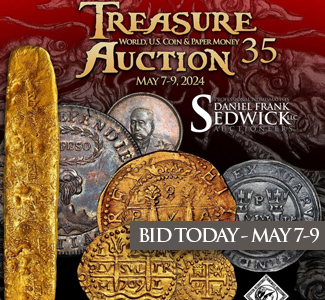By Mike Markowitz for CoinWeek …..
ATHENS IN THE eighth century was a provincial small town living on memories of past glories. But its aristocrats were proud of their daughters, reputedly the most talented and beautiful women in the Eastern Roman (“Byzantine”) empire. When Emperor Constantine V needed a bride for his son and heir, the future Leo IV (ruled 770-775) a 15-year-old Athenian girl named Irene (Eirene in Greek) was chosen. Shrewd and ruthless, she became the first woman to rule this fiercely masculine empire in her own right.
Her coinage is eagerly collected today.
Dynastic solidus
On September 8, 780, Leo IV died at the age of 31. Irene then became regent for her nine year-old son, Constantine VI. A gold solidus celebrates dynastic continuity; on the obverse three generations of deceased ancestors sit side by side: Leo III, Constantine V and Leo IV. Irene and her son appear on the reverse. She wears the imperial crown with triangular points and dangling strings of pearls (pendilia) that indicated “empress” to Byzantines.
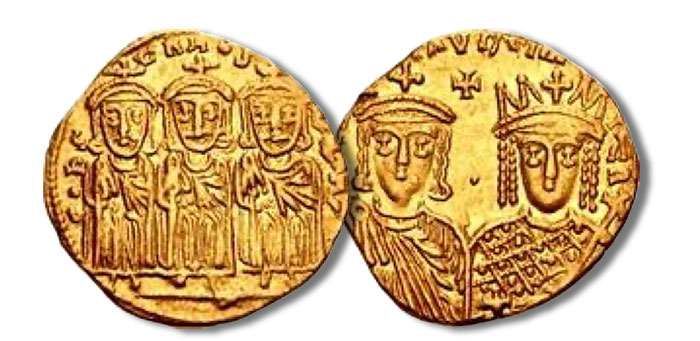
American numismatist Harlan Berk notes that this issue is “plagued with flat spots”, and the coin’s value depends on how many of the five portraits are fully struck up.
The blanks are often too small for the dies, so the inscriptions fall off the coin’s edge. In a recent US auction, a very fine example brought $2,750 USD[1].
Constantine & Irene
In a brilliant diplomatic move, Irene arranged the betrothal of her 11-year-old son to Rotrud, daughter of Karl, king of the Franks (better known as Charlemagne) in 782.
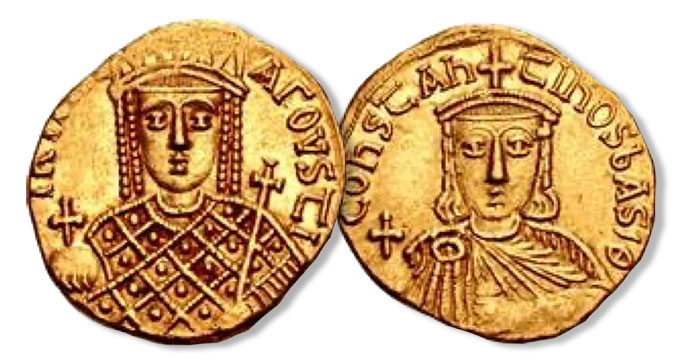
The marriage might have re-united Western and Eastern empires, but it was not to be; the engagement was broken off in 788 over territorial conflicts.
Young Constantine, restless under his mother’s tutelage, grew proficient at Palace intrigue and deposed her from power in 790. She outwitted him and regained control in 792. A new solidus dispensed with the row of dynastic ancestors. Irene appears alone on the obverse with the inscription IRINH AGOUSTI (spelling in this era often mixed Greek and Latin alphabets haphazardly). “Augusta” was a traditional Roman title for an emperor’s wife or mother. Constantine, beardless to indicate his youth, appears on the reverse. A near EF example of this scarce type (issued 793-797) brought $2,500 in a recent US auction[2].
Irene Alone
Irene refused to give up power when her son came of age, and in 797 she staged a palace coup. Constantine VI was brutally blinded, eventually dying in prison, and Irene reigned as sole empress (blinding, which made the victim ineligible for the throne, was considered more merciful than beheading).
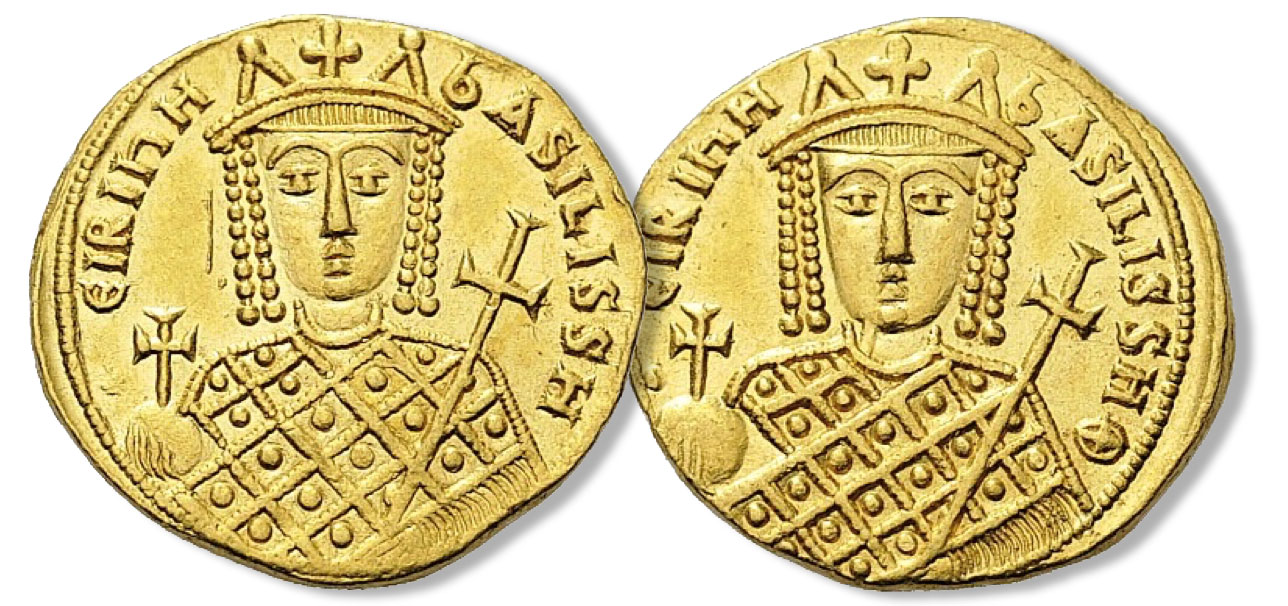
Deposed by a palace coup in 802, Irene died in exile a year later.
But in that last year, and having no successor to place on the reverse of her coinage, Irene displayed her crowned portrait on both sides of her solidus – as if to say, “Heads I win, tails you lose”. She wears the loros, a richly embroidered jeweled garment reserved for the ruler, and holds the imperial orb and cross-tipped scepter[3]. The inscription is ЄIRIhH bASILISSH, “to empress Irene”.
Referenced as Sear 1599[4], or DOC 1c[5], this type is not extremely rare, but demand is strong because of its dramatic story. A dealer once told me that if he had a hundred Irene solidi, he could sell them all in an afternoon. Current prices range from about $1,500 to over $16,000 for exceptionally high-grade specimens.
Syracuse
Strongly fortified, with a superb natural harbor and a reliable year-round fresh water source from the famous Arethusa spring, Syracuse was the capital of Byzantine Sicily. Distant from Constantinople’s imperial mint, Syracuse produced crudely executed local coinage on a reduced weight standard.
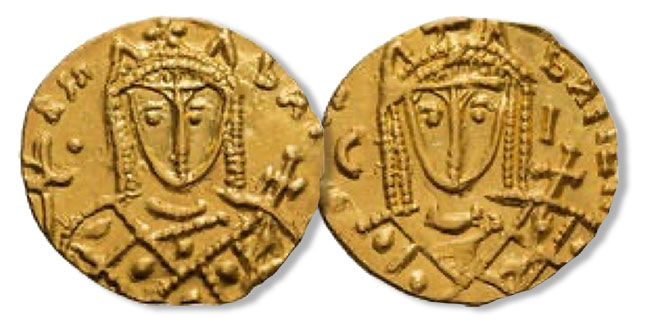
In a recent US auction, a splendid example sold for $5,000[6].
Miliaresion
The silver miliaresion, weighing under two grams and over-valued at 12 to the solidus, filled the gap between gold and humble copper.
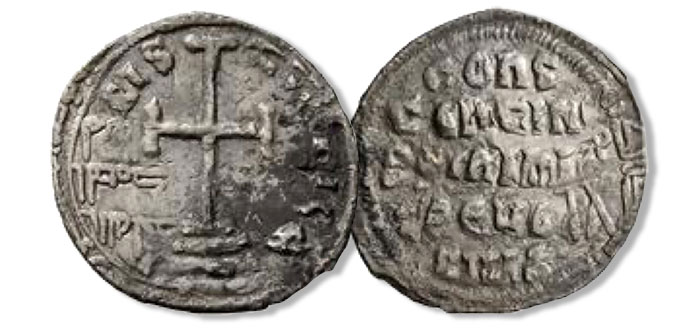
Introduced by Leo III in 720, the obverse bore a cross on three steps with the triumphant Greek inscription IҺSЧS XRISTЧS NICA (“Jesus Christ Conquers”). The reverse inscription in several lines identified the ruler and co-ruler. Many are overstruck on Islamic dirhams, obtained in trade or as booty. On some the underlying Arabic inscription is partly visible[7].
Follis
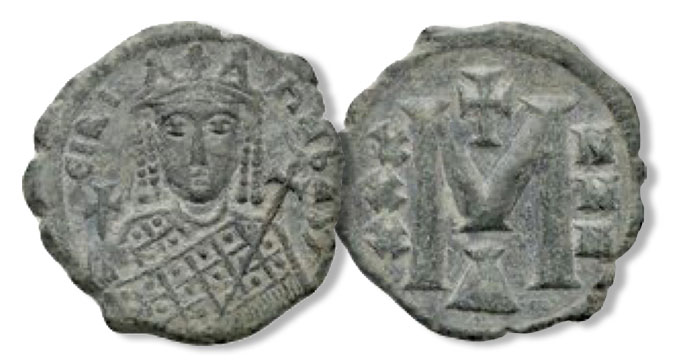
Irene’s copper coins are usually badly struck and heavily worn; well-preserved examples command high prices. The only denomination was the follis, weighing about 2.5 – 3 grams during the regency, increasing to 4 – 6 grams during her sole reign[8].
* * *
Notes
[1] CNG Auction 114, May 13, 2020, Lot 1050. Realized $2,750 USD (estimate $1,000).
[2] CNG Triton XXIII, January 14, 2020, Lot 930. Realized $2,500 USD (estimate $4,000).
[3] Nomos 8, October 21, 2013, Lot 254. Realized CHF 8,500 (about $8,928 USD; estimate CHF 10,000).
[4] Sear, 305
[5] Grierson, 349
[6] Harlan J. Berk, Sale 202, October 26, 2017, Lot 30. Realized $5,000 USD (estimate $6,000).
[7] Leu Numismatic Web Auction 5, September 23, 2018, Lot 1298. Realized CHF 140 (about $146 USD; estimate CHF 100).
[8] Numismatic Naumann Auction 75, March 3, 2019, Lot 781. Realized €1,300 (about $1,480 USD; estimate €800).
References
Berk, Harlan J. Roman Gold Coins of the Medieval World. Joliet, IL (1986)
Garland, Lynda. Byzantine Empresses. London (1999)
Grierson, Philip. Catalogue of the Byzantine Coins in the Dumbarton Oaks Collection, Volume 3, Part I. Washington (1973)
Herrin, Judith. Women in Purple: Rulers of Medieval Byzantium. Princeton (2001)
Sear David. Byzantine Coins and Their Values. London (1987)



